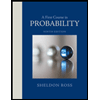1. An aluminum master alloy manufacturer produces grain refiners in ingot form. The company produce: the product in four furnaces. Each furnace is known to have its own unique operating characteristics s any experiment run in the foundry that involves more than one furnace will consider furnaces as a nuisance variable. The process engineer suspect that stirring rate affects the grain size of the product. Each furnace can be run at four different stirring rate.A randomized block design is run for a particular refiner, and the resulting grain size data is as follows. Stirring Rate (rpm) F1 F2 F3 F4 5 8 4 5 6 10 14 5 6 9 15 14 6 9 2 20 17 9 3 6 a) Is there any evidence that stirring rate affects grain size? Graph the residuals from this experiment on a normal probability plot. Interpret the plot. c) Plot the residuals versus furnaces and stirring rate. Does this plot convey any useful information? d) What should the process engineers recommend concerning the choice of stirring rate and furnace for this particular grain refiner if small grain size is desirable?
1. An aluminum master alloy manufacturer produces grain refiners in ingot form. The company produce: the product in four furnaces. Each furnace is known to have its own unique operating characteristics s any experiment run in the foundry that involves more than one furnace will consider furnaces as a nuisance variable. The process engineer suspect that stirring rate affects the grain size of the product. Each furnace can be run at four different stirring rate.A randomized block design is run for a particular refiner, and the resulting grain size data is as follows. Stirring Rate (rpm) F1 F2 F3 F4 5 8 4 5 6 10 14 5 6 9 15 14 6 9 2 20 17 9 3 6 a) Is there any evidence that stirring rate affects grain size? Graph the residuals from this experiment on a normal probability plot. Interpret the plot. c) Plot the residuals versus furnaces and stirring rate. Does this plot convey any useful information? d) What should the process engineers recommend concerning the choice of stirring rate and furnace for this particular grain refiner if small grain size is desirable?
A First Course in Probability (10th Edition)
10th Edition
ISBN:9780134753119
Author:Sheldon Ross
Publisher:Sheldon Ross
Chapter1: Combinatorial Analysis
Section: Chapter Questions
Problem 1.1P: a. How many different 7-place license plates are possible if the first 2 places are for letters and...
Related questions
Question
100%

Transcribed Image Text:1. An aluminum master alloy manufacturer produces grain refiners in ingot form. The company produces
the product in four furnaces. Each furnace is known to have its own unique operating characteristics so
any experiment run in the foundry that involves more than one furnace will consider furnaces as a nuisance
variable. The process engineer suspect that stirring rate affects the grain size of the product. Each furnace
can be run at four different stirring rate.A randomized block design is run for a particular refiner, and the
resulting grain size data is as follows.
Stirring Rate (rpm) F1 F2 F3
F4
5
8
4
5
6
10
14
5
6
9
15
14
6
9
2
20
17 9 3 6
a) Is there any evidence that stirring rate affects grain size?
b) Graph the residuals from this experiment on a normal probability plot. Interpret the plot.
c) Plot the residuals versus furnaces and stirring rate. Does this plot convey any useful information?
d) What should the process engineers recommend concerning the choice of stirring rate and furnace for this
particular grain refiner if small grain size is desirable?
e) Compute the corrected relative efficiency of RBD in comparison with CRD. Is blocking is effective in this
experiment?
Expert Solution
This question has been solved!
Explore an expertly crafted, step-by-step solution for a thorough understanding of key concepts.
This is a popular solution!
Step 1: The "Model F-Value" of 0.85 implies is not significant relative to the noise.
VIEWStep 2: There is a 49.95% chance that a {Modal F-Value " this large could occur due to noise
VIEWStep 3: The plot indicates that normally assumption is valid
VIEWStep 4: There are really is no effect due to the stirring rate.
VIEWSolution
VIEWTrending now
This is a popular solution!
Step by step
Solved in 5 steps with 4 images

Recommended textbooks for you

A First Course in Probability (10th Edition)
Probability
ISBN:
9780134753119
Author:
Sheldon Ross
Publisher:
PEARSON


A First Course in Probability (10th Edition)
Probability
ISBN:
9780134753119
Author:
Sheldon Ross
Publisher:
PEARSON
